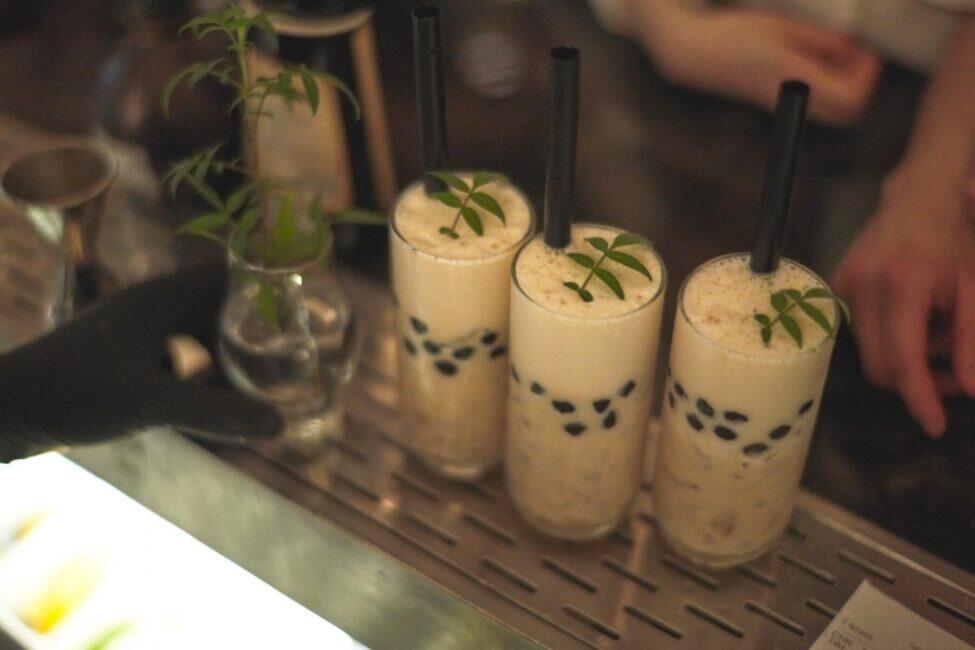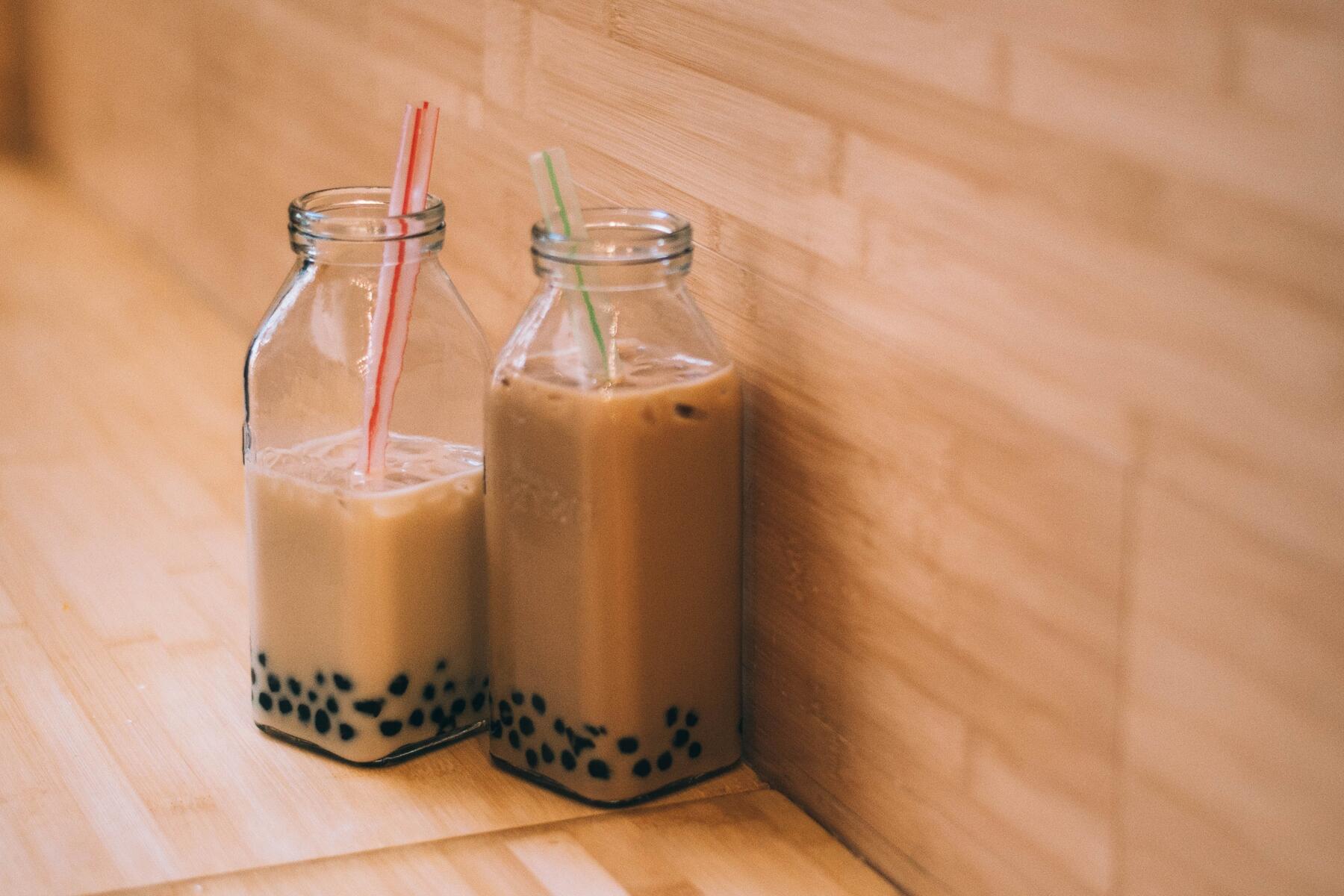Taiwan's bubble tea has seduced fans worldwide with its sweet taste and squishy balls that swirl like tapioca marbles at the bottom of the cup.
Named after the ample bosom of a Hong Kong erotic movie actress, bubble tea has the same number of calories as your average breakfast, requires the use of a straw so wide you could jam your finger down one end, and has odd gloopy bits in it. Yet it has become a global phenomenon. People are loving it so much that a 2020 report predicted that the global market for the beverage is expected to reach $4.3 billion by 2027.
Invented in 1980s Taiwan, where it quickly caught on as a treat to ease the heat of the sweltering summers, it’s now won fans around the world, seduced by its sweet and creamy taste and squishy tapioca balls that swirl like frog spawn at the bottom of the cup.
Bubble tea thrived here first because it chimes with the Taiwanese palate for “QQ.” This is a term used to describe foods that are extra soft and bouncy—a texture comparable to that of a really good marshmallow.
“Taiwanese have a crazy appetite for any food that is QQ,” says Mr. Wu, a 20-something bubble-tea-lover from Kaohsiung, Taiwan’s second-biggest city. “The balls in bubble tea are fun to chew but not difficult to swallow. And they make your brain happy because you think you’re eating.”
Recommended Fodor’s Video
Taiwan’s urban areas crawl with bubble tea hole-in-the-wall shops, where you can pick up a cup for as little NT$45 (around USD $1.50). The basic recipe is simple: take one cup of black tea, a spoonful or two of creamer, a shovel of ice, sugar to taste, add in a scoop of some kind of jellied balls, give it all a vigorous shake, and voila. Watching it being made, is, as one Taiwan ex-pat noted, like watching a bizarre modern-day tea ceremony.

Varieties have proliferated since the 1980s. Menus now have a bewildering array of choices including the addition of red beans, jelly cakes, apricot jellies, taro, sweet potato, nut milk, and even a boiled egg. A recent fad for brown sugar bubble tea, pioneered by Taiwan’s Tiger Sugar brand is still going strong. There’s no tea, actually—it’s just a creamy blend of brown sugar syrup, milk, and tapioca balls. What catapulted it to fame is its Instagrammable good looks: The syrup makes beautiful lava lamp-like caramel streaks that pattern the outside of the see-through cup.
Drinking tea cold rather than hot was the first revolution in tea culture in Taiwan, says Angela Liu, Associate Vice President at Chun Shui Tang, one of two teahouses that claim to have invented bubble tea in the 1980s. The bubbles back then were real bubbles—the froth on top from all that shaking. “Just like a beer,” adds Liu, who is the daughter of the teahouse’s founder. The Taiwanese have long put food in their tea (such as small berries and fruits), so it was just one extra step for someone to pop in a few tapioca balls, already a common addition to local desserts.
The tapioca balls back then were small, the size of pearls, and the tea was known as Pearl Milk Tea or zhenzhu naicha (珍珠奶茶), a name it still goes by in Taiwan. The name boba cha (波霸茶) is a younger coinage, from about 2000, says Liu. Vendors started selling bubble tea with bigger balls (blueberry-sized) and so they called it boba cha, meaning “big breast tea,” to distinguish it from the traditional variety. Boba was also the nickname for Amy Yip, a particularly well-endowed Hong Kong actress who starred in steamy movies like Sex and Zen and Erotic Ghost Story II.
Bobas have since gained a following of their own, without their tea medium. You can find these chewy spheroids spattered on pizzas, topping cheesecakes, hiding in hotpots, and even bobbing about in bowls of ramen.
Chun Shui Tang offers a classic version of the drink (NT$90). It comes in an ice-cream sundae glass with the option of using a spoon to save on straws. Whether from being drunk in a glass rather than a plastic cup, or the fact the tapioca balls are frozen and thus preservative-free, according to Liu, Chun Shui Tang’s tea tastes cleaner, the flavor of the brew is sharper, and the pearls are perfectly QQ. It’s fun to consume this modern tea concoction in a historical setting. Chun Shui Tang has a branch in the iconic National Concert Hall in Taipei, where you can enjoy your tea to the strains of classical Chinese music and seated on traditional wooden furniture.

Disarmingly refreshing, a cup packs in the calories though; you’re looking at approximately 400 per regular cup. That’s about what we should be eating for an average breakfast. But there are ways to make it healthier. Ask for zero sugar; choose black, green or fruit tea to ditch the fat from the creamer or milk; and finally, swap out the syrup-soaked tapioca balls for something healthier but still QQ-y. Options are plentiful and include grass jelly (from boiled leaves), aloe vera, and konjac jelly (boiled underground plant stem) to name just a few. These taste better than they sound.
Another issue with takeaway bubble tea, which five minutes outside any high street teashop in Taipei will make immediately obvious, is the sheer amount of plastic waste that is generated. Each bubble tea purchase comes in a disposable plastic cup, sealed with a plastic lid and a thick straw wrapped in its own plastic throwaway sheath. Tang An, a plastics campaigner at Greenpeace East Asia’s Taipei office estimates that “in Taiwan, we consume 3.8 billion single-use cups a year,” and advises bubble tea lovers “bring their own reusable straws and cups.”
At first sip, bubble tea doesn’t seem like it would translate well as an alcoholic drink, and a search for boozy versions in Taipei only turned up two results.
Tea to Tea, a boutique drinks shop in Taipei’s tourist district of Dongmen, is run by a husband-and-wife team who source their tea leaves from their family farm in central Taiwan. Unlike most bubble tea shops that only serve takeaway, Tea to Tea has a little deck and an indoor bar with some seating. Two items on their expansive menu are alcoholic. The Lychee Liqueur Tea (NTD100 or USD $3.50) is tangy and fruity with a shot of Dita (the eponymous lychee liqueur) and a floating suspension of snow mushrooms. The Pearl Irish Cream (NTD90 or US$3.20) has a single shot of gin, which is just detectable within its rich and chocolatey body. You’d need quite a few to get tipsy, though.
On the other hand, two or three HardKor Boba Teas (NTD400, or USD $14) would easily get you feeling merry but as it’s quite filling, you may not want to drink more than one. This oolong-infused vodka with honey and hazelnut is a specialty cocktail at KOR, a nightclub in downtown Taipei. Looking deceptively innocent in its frosted glass, with only a sprig of mint floating on the top to distinguish it by looks from a regular bubble tea, the vodka delivers a noticeable kick to the stomach.
Over the past 30 years, bubble tea has become an integral part of Taiwanese culture and identity, as this progressive democracy struggles to be seen on the international stage.
Over the past 30 years, bubble tea has become an integral part of Taiwanese culture and identity, as this progressive democracy struggles to be seen on the international stage. These days, you can find its iconic image—complete with cheeky straw and lines of tapioca pearls—on everything from keyrings, to phone covers and boxer shorts to passport designs. It’s even part of a youth anti-authoritarian activist movement in Southeast Asia called the Milk Tea Alliance—each geographic region identified by the shade of their version of the drink.
Bubble tea has come to embody a local identity that sets Taiwan apart from the other countries in the region and the world. This is important, with much of Taiwan’s culinary culture adapted from overseas—mainly Japan, China, and the U.S.—bubble tea is something that is indisputably Taiwanese and something fun and popular that it can proudly claim as its own.




